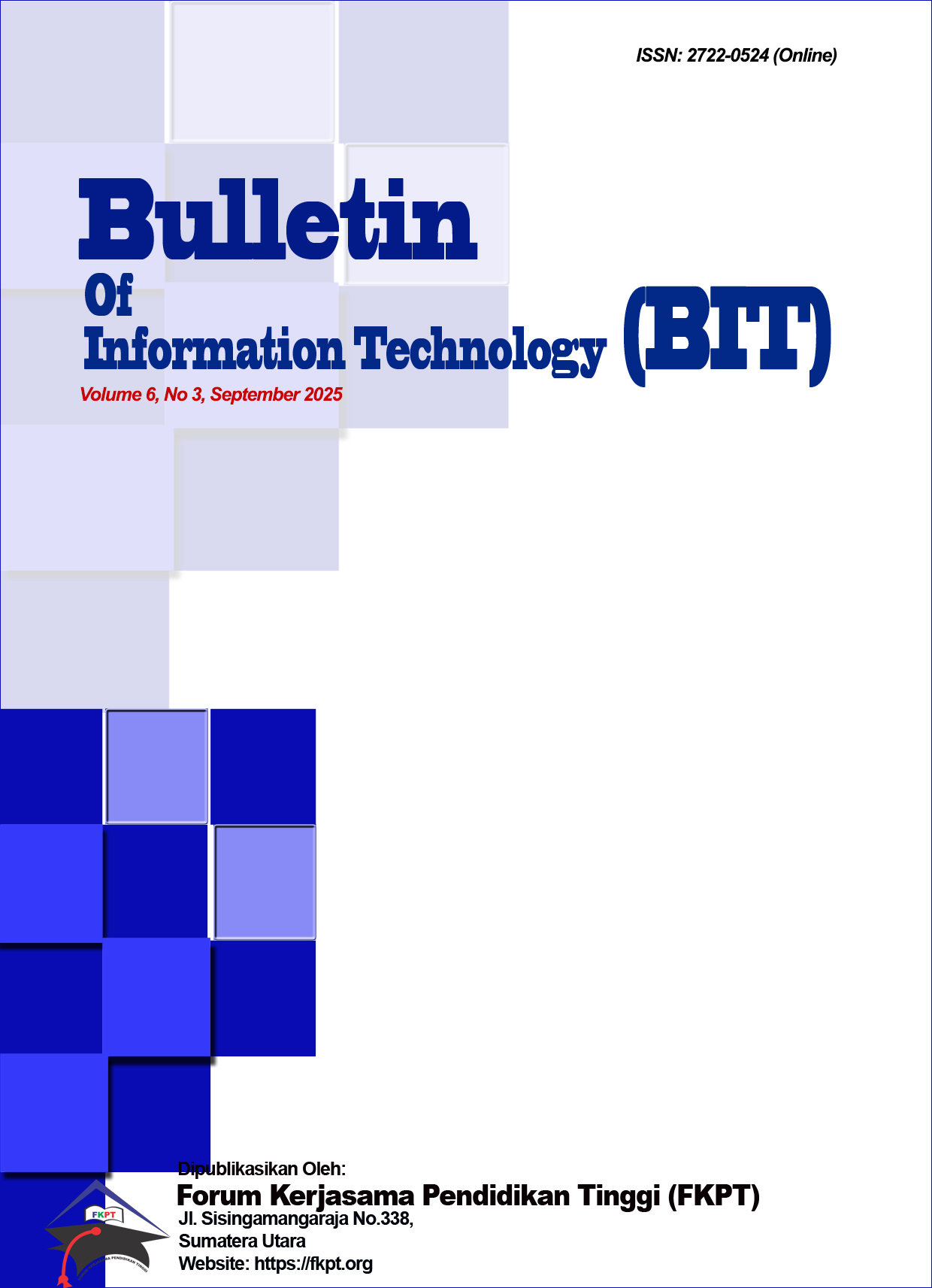Face Recognition Motorcycle Rider Registration System for Rider Data Management
Abstract
This research aims to develop a motorcycle rider registration system using facial recognition technology that can improve the efficiency of rider data management. This system is designed to identify and authenticate riders with high accuracy, thereby simplifying the registration and monitoring process. The methods used in this research include collecting rider facial data through cameras, image processing for feature extraction, and implementing a facial recognition algorithm. Testing was conducted in several locations with varying lighting conditions and viewing angles to ensure the system's robustness. The results show that the developed system is capable of achieving facial recognition accuracy of up to 95%. In addition, this system provides an intuitive user interface to facilitate the registration and data management process. With the implementation of this system, it is expected to reduce the time and costs required in managing motorcycle rider data, as well as improve safety and comfort while riding.
References
A. Kaifan and F. A. Gani, “Model Pemilihan Moda Antara Sepeda Motor Dan Bus Kota Di Kota Medan,” Portal: Jurnal Teknik Sipil, vol. 13, no. 1, pp. 17–22, 2021.
S. Auliana, B. R. S. Permana, G. D. P. Aryono, and U. Masyuri, “Audit Sistem Informasi Input Data Kendaraan Bermotor Di Unit Pelayanan Teknis Daerah Samsat Kota Serang Menggunakan Framework Cobit 5,” CONTEN: Computer and Network Technology, vol. 4, no. 2, pp. 147–156, 2024.
S. Santoso, A. Saptono, and N. Pasaribu, “Analisa Sistem Informasi Pengarsipan Pembayaran Pajak Kendaraan Bermotor Pada Kantor Samsat Serpong,” Journal Sensi: Strategic of Education in Information System, vol. 6, no. 2, pp. 136–147, 2020.
A. Atianashie Miracle, “The Application of Computer in Motor Vehicle Registration over Manual System,” Int. J. Sci. Res. in Computer Science and Engineering Vol, vol. 11, no. 2, 2023.
S. Wahyuni and F. Wadly, “Application Of Inventory And Service Transactions On Web-Based Cv Medan Teknik using the Agile Kanban Method,” International Journal Of Computer Sciences and Mathematics Engineering, vol. 2, no. 1, 2023.
M. R. Maulana and S. S. P. Kastiady, “Implementasi Teknologi Informasi Untuk Meningkatkan Efisiensi Penerimaan Beban Administrasi Pajak Kendaraan Bermotor Di Badan Pendapatan Daerah Provinsi Jawa Tengah,” Jurnal Ilmiah Wahana Pendidikan, vol. 10, no. 11, pp. 440–447, 2024.
A. M. Putra, T. D. Cahyani, and S. Al-Fatih, “Analisis Sosiologi Hukum Efektivitas Penerapan Sanksi Denda E-Tilang Berbasis Electronic Traffic Law Enforcement (ETLE) Terhadap Pelanggaran Lalu Lintas Pengendara Sepeda Motor di Kota Malang,” Jurnal ISO: Jurnal Ilmu Sosial, Politik dan Humaniora, vol. 5, no. 1, pp. 1–12, 2025.
R. P. A. Nugroho, “Meningkatkan Performa Frontend dengan Menggunakan Framework Next. Js dalam Pengembangan Website,” Journal of Cyber Health and Computer, vol. 2, no. 2, pp. 14–19, 2024.
H. M. F. Turnip, N. J. B. Laia, R. D. Zebua, B. kristoven Waruwu, M. B. Nduru, and A. P. Harianja, “Perancangan Sistem Parkir di Universitas Katolik St. Thomas Berbasis Website,” in Seminar Nasional Inovasi Sains Teknologi Informasi Komputer, 2023, pp. 250–258.
F. F. Hadianto and A. Suwandi, “Aplikasi Sistem Manajemen Parkir Berbasis Website Di Universitas Wiraraja Madura,” Ge-STRAM: Jurnal Perencanaan dan Rekayasa Sipil, vol. 7, no. 1, pp. 24–29, 2024.
R. Fajri, “Implementasi Radio Frequency Identification Sebagai Sistem Keamanan Sepada Motor Berbasis Arduino,” Sisfo: Jurnal Ilmiah Sistem Informasi, vol. 9, no. 1, pp. 51–62, 2025.
S. P. Agustanti, H. Hartini, and D. A. Nugraha, “PERANCANGAN SISTEM KEAMANAN SEPEDA MOTOR BERBASIS RFID MIKROKONTROLER ESP8266,” Jusikom: Jurnal Sistem Komputer Musirawas, vol. 8, no. 1, pp. 19–29, 2023.
R. P. A. Nugroho, “Meningkatkan Performa Frontend dengan Menggunakan Framework Next. Js dalam Pengembangan Website,” Journal of Cyber Health and Computer, vol. 2, no. 2, pp. 14–19, 2024.
R. Prasetyo, A. Nugroho, and A. Sugandi, “Meningkatkan Performa Frontend dengan Menggunakan Framework Next.Js dalam Pengembangan Website,” Journal of Cyber Health and Computer, vol. 2, no. 2, 2024, doi: 10.18196/jochac.v3i4.
Copyright (c) 2025 Kana Saputra S, Insan Taufik, Irham Ramadhani, Putri Sasalia S, Yusfi Syawali, Dede Yusuf, Rezkya Nadilla Putri, Najwa Latifah Hasibuan, Fauzan Hafiz Harahap

This work is licensed under a Creative Commons Attribution 4.0 International License.
Authors who publish with this journal agree to the following terms:
- Authors retain copyright and grant the journal right of first publication with the work simultaneously licensed under Creative Commons Attribution 4.0 International License that allows others to share the work with an acknowledgment of the work's authorship and initial publication in this journal.
- Authors are able to enter into separate, additional contractual arrangements for the non-exclusive distribution of the journal's published version of the work (e.g., post it to an institutional repository or publish it in a book), with an acknowledgment of its initial publication in this journal.
- Authors are permitted and encouraged to post their work online (e.g., in institutional repositories or on their website) prior to and during the submission process, as it can lead to productive exchanges, as well as earlier and greater citation of published work (Refer to The Effect of Open Access).




.png)
.png)



